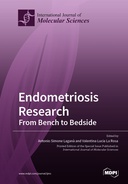Explore

Endometriosis Research
0 Ungluers have
Faved this Work
Login to Fave
Endometriosis is defined as the presence of endometrial-like endometrial cells, glands, and stroma outside the uterus, causing a strong inflammatory-like microenvironment in the affected tissue. The exact prevalence of endometriosis is unknown, but estimates range from 2%–10% of women of reproductive age, to 50% of infertile women. Its etiopathogenesis of endometriosis still remains controversial—immune, hormonal, genetic, and epigenetic factors may be all involved, and several theories have been proposed to explain it.This book aims to summarize recent ground-breaking studies that may open new scenarios and change the perspective of the topic, including cutting-edge elements about diagnosis, pharmacologic and surgical treatments, as well as basic/translational science (immunology, cell biology, genetics, and epigenetics) pieces of evidence, to unravel new pathways to follow for the future diagnosis and management of endometriosis, and to improve our current knowledge of its aetiology.
This book is included in DOAB.
Why read this book? Have your say.
You must be logged in to comment.
Rights Information
Are you the author or publisher of this work? If so, you can claim it as yours by registering as an Unglue.it rights holder.Downloads
This work has been downloaded 102 times via unglue.it ebook links.
- 102 - pdf (CC BY) at Unglue.it.
Keywords
- aetiology
- Angiogenesis
- aquaporin
- ATP
- biomarker
- BTG1
- CFTR
- chloride channels
- Cytokines
- endometriosis
- endometrium
- epigenetics
- Etiology
- genetic polymorphisms
- Genetics
- human endometrial stromal cells
- immunology
- Ion Channels
- medicine
- Mediterranean population
- microenvironment
- Pathogenesis
- peritoneal fluid
- precision medicine
- purinergic signaling
- Sardinian population
- SNPs
- urinary biomarkers
- uterus
Links
DOI: 10.3390/books978-3-0365-2798-7Editions

